Žacléř
Žacléř (Czech pronunciation: [ˈʒatslɛːr̝̊]) (German: Schatzlar) is a town in Trutnov District in the Hradec Králové Region of the Czech Republic. It has about 3,100 inhabitants. The town centre is well preserved and is protected by law as an urban monument zone.
Žacléř | |
|---|---|
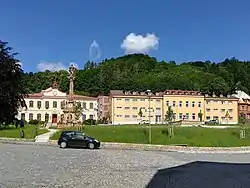 Rýchorské Square with the town hall | |
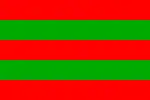 Flag  Coat of arms | |
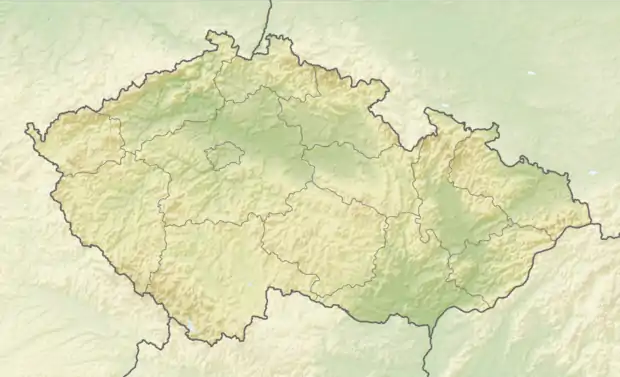 Žacléř Location in the Czech Republic | |
| Coordinates: 50°39′49″N 15°54′41″E | |
| Country | |
| Region | Hradec Králové |
| District | Trutnov |
| First mentioned | 1334 |
| Government | |
| • Mayor | Aleš Vaníček |
| Area | |
| • Total | 21.82 km2 (8.42 sq mi) |
| Elevation | 612 m (2,008 ft) |
| Population (2021-01-01)[1] | |
| • Total | 3,126 |
| • Density | 140/km2 (370/sq mi) |
| Time zone | UTC+1 (CET) |
| • Summer (DST) | UTC+2 (CEST) |
| Postal code | 542 01 |
| Website | www |
Administrative parts
Villages of Bobr and Prkenný Důl are administrative parts of Žacléř.
History
_04.jpg.webp)
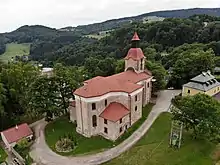
Žacléř was founded on the Silesian trail, which was a trade route from Trutnov to Wrocław. A guarding castle for the protection of the trail was built here probably during the reign of Ottokar II of Bohemia, around 1260. The first written mention of the castle is from 1334.[2]
From 1570, hard coal was mined here and from 1670, beer was brewed here. In the 19th century, the industrialization occurred. Paper mill, glassworks, and factories for textile, ceramics or soda were founded, but almost all operation ended during the 20th century. In 1992, the coal mining ended.[2]
During the World War II, the German occupiers operated a women subcamp of the Gross-Rosen concentration camp in the town. The prisoners were mostly of Jewish women deported from German-occupied Poland and Hungary. The camp was liberated on 8 May 1945, coincidentally the day of the end of World War II in Europe.[3]
Economy
The ceramics factory was founded in 1878 and it is the only factory in Žacléř which has survived to this day.[2] Since 1994, the company operates under the name Keramtech, s.r.o.[4]
Sights
The Church of the Holy Trinity was built in 1677 by Jesuits and baroquely rebuilt in 1732. The rectory next to the church is a late Baroque building from 1793.[5]
The Renaissance Žacléř Castle was originally a Gothic castle, which burned down in 1523 and was rebuilt in the 16th century. It is inaccessible to the public.[6]
In the former Jan Šverma Mine there is the Mining Open-air museum Žacléř. It focuses on the mining equipment and history of mining in Žacléř, and on paleontological findings uncovered during mining.[7] The history of the town and a porcelain collection are shown in the Town Museum.[8]
Twin towns – sister cities
Žacléř is twinned with:
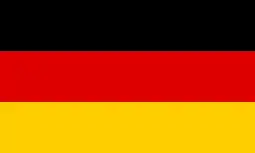 Goldkronach, Germany[9]
Goldkronach, Germany[9]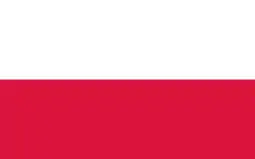 Kowary, Poland[10]
Kowary, Poland[10] Lubawka, Poland[11]
Lubawka, Poland[11] Lwówek Śląski County, Poland[12]
Lwówek Śląski County, Poland[12]
Gallery
 Panorama of Žacléř
Panorama of Žacléř Žacléř Castle
Žacléř Castle Marian column
Marian column Sculpture of Saint Florian
Sculpture of Saint Florian
References
- "Population of Municipalities – 1 January 2021". Czech Statistical Office. 2021-04-30.
- "Město Žacléř" (in Czech). Město Žacléř. Retrieved 2021-09-25.
- "Subcamps of KL Gross- Rosen". Gross-Rosen Museum in Rogoźnica. Retrieved 13 November 2021.
- "Historie výroby keramiky v Žacléři" (in Czech). Keramtech, s.r.o. Retrieved 2021-09-25.
- "Kostel Nejsvětější Trojice v Žacléři" (in Czech). Kudy z nudy. Retrieved 2021-09-25.
- "Renesanční zámek Žacléř" (in Czech). Kudy z nudy. Retrieved 2021-09-25.
- "Historie" (in Czech). Důl Jan Šverma o.p.s. Retrieved 2021-09-25.
- "Městské muzeum Žacléř" (in Czech). Město Žacléř. Retrieved 2021-09-25.
- "Žacléřský zpravodaj č.8/2019" (PDF) (in Czech). Město Žacléř. August 2019. p. 2. Retrieved 2020-09-03.
- "Raport o stanie miasta Kowary" (in Polish). Biuletyn Informacji Publicznej Miasta Kowary. 2018. p. 128. Retrieved 2020-09-03.
- "Main Page" (in Polish). Gmina Lubawka. Retrieved 2020-09-03.
- "Miasto Žacléř" (in Polish). Lwówek Śląski County. Retrieved 2020-09-03.